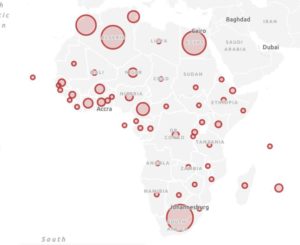This blog is a part of #COVID19Africa Series. Click for French version
Guinea’s health sector is primarily public. The first line of healthcare consists of more than 410 public health facilities, some 100 private non-profit facilities, and many private for-profit doctors’ offices.
Even before the first COVID-19 case was reported in Guinea on 12 March 2020, the National Health Security Agency (ANSS) had already alerted the health facilities, the health authorities and the communities to the need to reactivate the strategies rolled out during the Ebola epidemic. The health centres, that gained extensive experience during the previous crisis, are key in the set-up of a rapid response mechanism. On 3 April 2020, Guinea had 111 confirmed COVID-19 cases, including 1 cured.
The first line of care has a far more prominent role to play during this coronavirus pandemic than during the Ebola epidemic where their main role was the detection and referral of patients and the promotion of prevention measures. Now, they must monitor screened patients and focus on a confined population.
However, the district management teams to which they report have not received the relevant operational response tools such as hand washing kits and personal protective gear. Some regional supply depots do not even have gloves and the staff is not properly trained. The shortage is exacerbated by tension and bickering among the National Health Security Agency (ANSS) and the Ministry of Health. The situation prompted the President of the Republic to bang his fist on the table and make the protagonists, the Minister of Health and the Director-General of the National Health Security Agency (ANSS), swear that they would wage war together on COVID-19.
In Guinea only one accredited treatment centre and one laboratory are capable of PCR screening for COVID-19, both of them in Conakry. The National Health Security Agency (ANSS) has planned to decentralise testing but this scheme is not operational yet.
One of the first cases of COVID-19 was identified in Labé, in the centre of Guinea, on 1 April 2020, with the help of a community worker affiliated to a health centre. The patient had consulted two first level healthcare facilities, that are now closed, before being transferred to Conakry, 450 km away, by the ambulance of the regional hospital. Contact tracing is being carried out.
At the beginning of the COVID-19 epidemic, the Guinean population felt unconcerned because according to the rumours this was “a Chinese, a white men’s and finally a rich “bosses” disease” that mainly hit high-ranking individuals such as a minister and the chief official of a republican institution.

Panic broke out as a result of more rumours, fake news and the state of emergency that was declared with immediate effect. Restrictions included the closure of all places of worship, a ban on group gatherings, a limit on the number of people allowed on public transport. The closure of mosques and the cancellation of Friday prayers are seen by the population (85% of whom are Muslim) as a violation of faith.
Media and social networks are popular and have been reporting about the restrictions and therapeutic methods for weeks. The hydroxychloroquine (HCQ or chloroquine as it is known in Guinea) media hype is closely followed. The product was withdrawn from the therapeutic arsenal against malaria in 2005. The flood of information on HCQ in recent days led the people to stockpile, first from pharmacies and when these ran out, from the flourishing black market. In the city of Boké all the Nivaquine strips sold out in one day as families used the drug as a preventive treatment. According to another rumour people should drink hot water or warm broth to kill the virus in the throat before it descends into the respiratory tract.
All this means that medical staff must not only give care but also deal with rumours, fake news and prejudices. Doctors organise themselves through their professional bodies to take up their role in local facilities and deal with all the health problems of their communities.A WhatsApp group was set up and email communication between doctors organised. Those of the non-profit-sector are all working on advocacy programmes for access to screening kits, protective equipment, information and training .
Most care providers feared the consequences of the shortage of protective equipment and the lack of support from the public authorities and their exclusive focus on public health centres. The doctors need protective measures, personalised appointments with the chronically ill, surveillance of people that recently returned from affected countries, a work schedule that reduces the number of staff in doctors’ offices, the use of informative posters, the use of all contacts to pass messages and fight against fake news.
Other initiatives like local production of reusable masks, a television screen in the waiting room to display information, targeted home visits and broadcasting health education through local radio stations might be useful.
About the authors :
Abdoulaye Sow is a general practitioner, public health expert and director of the Guinean NGO Fraternité Médicale Guinée. He is supporting first line healthcare services and involved in the training of family doctors in Guinea.
Bart Criel is a medical doctor and currently professor at the Public Health Department of the Institute of Tropical Medicine
Conflict of Interests: None